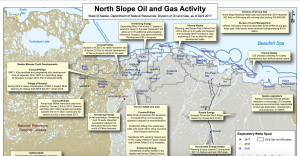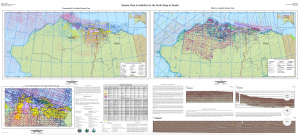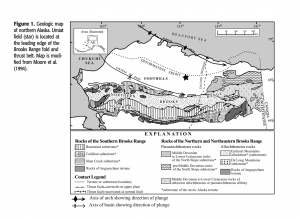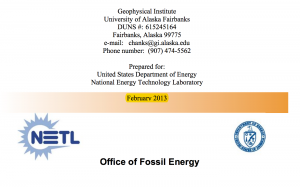Historical Background
During the early 1920’s, the U.S. Geological Survey concluded that there were numerous geologic features likely to contain oil and gas within what is now known as the National Petroleum Reserve – Alaska. The U.S. Navy confirmed the Umiat oilfield in the 1940’s during the next phase of early exploration. Twelve historical oil wells were drilled through 1979. During 2013 and 2014, Malamute’s predecessor-owner drilled two modern oil wells (one vertical and one horizontal), extracted over 360 ft of conventional core through the lower reservoir interval, and flow tested the horizontal well. Significant technical work defined reserves and furthered understanding of possible methods to produce light oil from the permanently frozen (permafrost) reservoir. Recent North Slope discoveries in the Nanushuk Formation rocks could also herald a new, unexplored pay type at Umiat, whose Nanushuk Formation rocks have never been tested.
Umiat Project Maps
3rd Party Studies
-
Brookian Topset StratPlay AGS (2018)
-
Nanushuk Brookian Discoveries – Alaska DNR (2017)
-
Umiat Simulation – Hanks et al (2014)
-
DOE Reservoir Characterization – Hanks et al (2013)
-
Reservoired Oil Resources – Alaska DNR (2011)
-
Producing Light Oil – Hanks et al (2011)
-
Characteristics Fluid Flow – Godabrelidze (2010)
-
Sedimentary and Sequence Stratigraphy – USGS (2004)
-
Geology of the Nanushuk Pt.1 – USGS (1985)
-
Geology of the Nanushuk Pt.2 – USGS (1985)
-
Geology of the Nanushuk Pt.3 – USGS (1985)
-
Geology of the Nanushuk Pt.4 – USGS (1985)
-
Field Geology – Molenaar/USGS (1982)
-
Study of Umiat Well 11 – USGS (1979)
-
Drilling Muds Umiat – Bureau of Mines (1960)
-
Oil Recovery Permafrost – Bureau of Mines (1960)
-
Crude Oil Analysis – Bureau of Mines (1959)

























